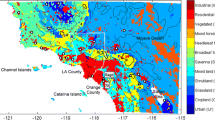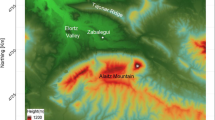Abstract
The concept of blending height is used to estimate areally averaged surface fluxes of momentum and heat in a stratified, horizontally inhomogeneous surface-layer flow. This concept is based on the assumption that at sufficiently large heights above a heterogeneous surface, subsequent surface modifications will not be recognizable in the flow individually, but overall flux and mean profiles will represent the surface condition of a large area. The height at which the flow becomes approximately independent of horizontal position is called blending height according to Wieringa (1986).
Here, it is proposed to classify the ground surface in a surface-layer grid box of a larger-scale model into several land-use categories. Surface momentum and heat fluxes should be estimated for each category at the blending height. The grid-averaged surface fluxes are to be obtained by the average of surface fluxes on each land-use surface weighted by its fractional area. The postulate of computing the surface fluxes at the blending height leads to a new formulation of turbulent transfer coefficients.
The proposed parameterization has been tested by employing a small-scale numerical model as a surface-layer grid box of a hypothesized larger-scale model. Several quite different flow configurations have been studied in order to investigate the performance of the new parameterization. Generally, the relative errors of estimated averaged surface fluxes are found to be well within ±10%.
Similar content being viewed by others
References
Anderson, D. A., Tannehill, J. C., and Pletcher, R. H.: 1984, Computational Fluid Mechanics and Heat Transfer, McGraw Hill Book Company, New York, 599pp.
Beljaars, A. C. M., Schotanus, P., and Nieuwstadt, F. T. M.: 1983. ‘Surface Layer Similarity Under Nonuniform Fetch Conditions’, J. Climate App. Meteorol. 22, 1800–1810.
Brutsaert, W.: 1979, ‘Heat and Mass Transfer to and from Surfaces with Dense Vegetation or Similar Permeable Roughness’, Boundary-Layer Meteorol. 16, 365–388.
Claussen, M.: 1987, ‘The Flow in a Turbulent Boundary Layer Upstream of a Change in Surface Roughness’, Boundary-Layer Meteorol. 40, 31–86.
Claussen, M.: 1988a, ‘Models of Eddy Viscosity for Numerical Simulation of Horizontally Inhomogeneous Surface Layer Flow’, Boundary-Layer Meteorol. 42, 337–369.
Claussen, M.: 1988b, ‘On the Surface Energy Budget of Coastal Zones with Tidal Flats’, Beitr. Phys. Atmosph. 61, 39–49.
Claussen, M.: 1989. ‘Subgrid-Scale Fluxes and Flux Divergences in a Neutrally Stratified, Horizontally Inhomogeneous Surface-Layer’, Beitr. Phys. Atmosph. 62, 236–245.
Claussen, M.: 1990, ‘Area-Averaging of Surface Fluxes in a Neutrally Stratified, Horizontally Inhomogeneous Atmospheric Boundary Layer’, Atmos. Environ. 24A, 1349–1360.
Claussen M.: 1991. ‘Local Advection Processes in the Surface Layer of the Marginal Ice Zone’, Boundary-Layer Meteorol. 54, in press.
Deardorff, J. W.: 1978, ‘Efficient Prediction of Ground Surface Temperature and Moisture with Inclusion of a Layer of Vegetation’, Jour. Geophys. Res. 83, 1889–1903.
Dolman, A. J.: 1987, ‘Predicting Evaporation from an Oak Forest’, Ph.D. thesis. Rijk-suniversiteit te Groningen. 91 pp.
Dyer, A. J.: 1974, ‘A Review of Flux-Profile Relationships’, Boundary-Layer Meteorol. 7, 363–372.
Hicks, B. B.: 1985, ‘Application of Forest-Atmosphere Turbulent Exchange Information’, The Forest- Atmosphere Interaction, D. Reidel Publishing Company, Dordrecht, pp. 631–644.
Hinze, H. O.: 1975, Turbulence. McGraw-Hill Book Comp., New York, 790pp.
Lettau, H. H.: 1979, ‘Wind and Temperature Profile Prediction for Diabatic Surface Layers Including Strong Inversion Cases’, Boundary-Layer Meteorol. 17, 443–464.
Louis, J. F.: 1979. ‘A Parametric Model of Vertical Eddy Fluxes in the Atmosphere’, Boundary-Layer Meteorol. 102, 924–933.
Mahrt, L.: 1987, ‘Grid-Averaged Surface Fluxes’, Mon. Wea. Rev. 15, 1550–1560.
Mason, P. J.: 1988, ‘The Formation of Areally-Averaged Roughness Lengths’, Quart. J. R. Meteorol. Soc. 114, 399–420.
Taylor, P. A.: 1969, ‘The Planetary Boundary Layer above a Change in Surface Roughness’, J. Atmos. Sci. 26, 432–440.
Wieringa, J.: 1986, ‘Roughness-Dependent Geographical Interpolation of Surface Wind Speed Averages’, Quart. J. R. Meteorol. Soc. 112, 867–889.
Wood, N. and Mason, P. J.: 1990, ‘The Influence of Stability on Effective Roughness Lengths’, Proc. of the 9th Symposium on Turbulence and Diffusion held in Roskilde, April 30th–May 3rd, 1990, pp. 247–249.
Author information
Authors and Affiliations
Rights and permissions
About this article
Cite this article
Claussen, M. Estimation of areally-averaged surface fluxes. Boundary-Layer Meteorol 54, 387–410 (1991). https://doi.org/10.1007/BF00118868
Accepted:
Issue Date:
DOI: https://doi.org/10.1007/BF00118868




